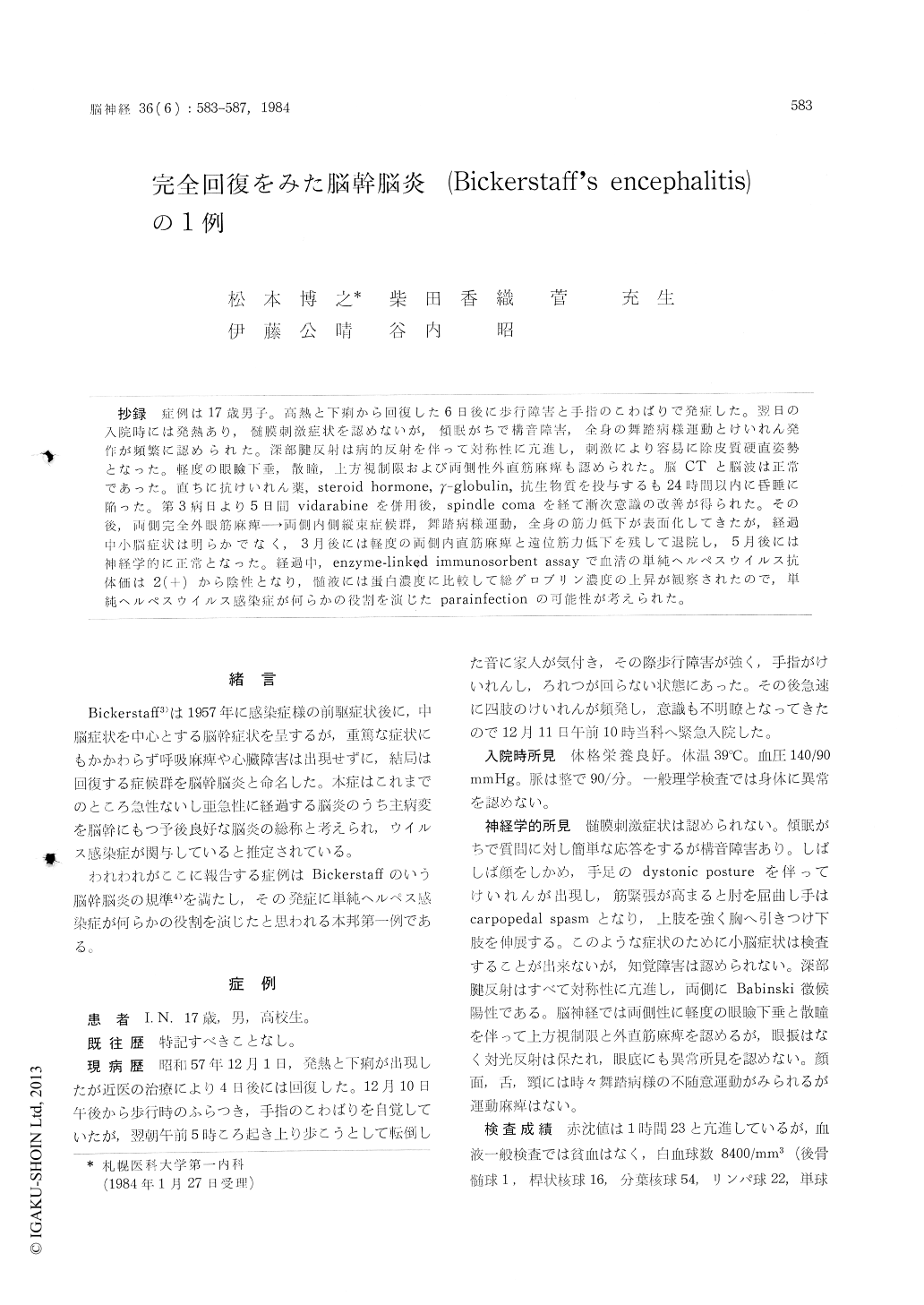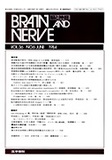Japanese
English
- 有料閲覧
- Abstract 文献概要
- 1ページ目 Look Inside
抄録 症例は17歳男子。高熱と下痢から回復した6日後に歩行障害と手指のこわばりで発症した。翌日の入院時には発熱あり,髄膜刺激症状を認めないが,傾眠がちで構音障害,全身の舞踏病様運動とけいれん発作が頻繁に認められた。深部腱反射は病的反射を伴って対称性に亢進し,刺激により容易に除皮質硬直姿勢となった.軽度の眼瞼下垂.散瞳,上方視制限および両側性外直筋麻痺も認められた。脳CTと脳波は正常であった。直ちに抗けいれん薬,steroid hormone,γ—globulin,抗生物質を投与するも24時間以内に昏睡に陥った。第3病日より5日間vidarabineを併用後,spindle comaを経て漸次意識の改簿が得られた。その後,両側完全外眼筋麻痺→両側内側縦束症候群,舞踏病様運動,全身の筋力低下が表面化してきたが,経過中小脳症状は明らかでなく,3月後には軽度の両側内直筋麻癖と遠位筋力低下を残して退院し,5月後には神経学的に正常となった.経過中,enzyme-linked immunosorbent assayでは血清の単純ヘルペスウイルス抗体価は2(+)から陰性となり,髄液には蛋白濃度に比較して総グロブリン濃度の上昇が観察されたので,単純ヘルペスウイルス感染症が何らかの役割を演じたparainfectionの可能性が考えられた。
A 17 year old high school boy experienced fever and diarrhea, which subsided within 4 days by appropriate medications. Six days later, how-ever, he developed unsteadiness and limb spasm. On the morning of admission, he was found to have drowsiness, dysarthria, gait disturbance and involuntary jerks. When he was brought to the hospital, he was lethergic but could follow simple verbal commands. Frequent involuntary movementsmanifesed by facial grimacings, limb spasms and twitchings with dystonic features were seen. Decorticate posturing was readily elicited by painful stimuli. There was no meningeal irritation sign or gross sensory impairment. The deep tendon reflexes were symmetrically exaggerated with bilateral Babinski signs. Bilateral lateral rectus muscle weakness was found together with mild ptosis and upward gaze limitation. Nystagmus was not present and the funduscopic examination was normal. Immediately he was placed on anticon-vulsants, steroid hormone, y-globulin and antibio-tics as well. A brain CT scan and a CSF examin-ation revealed no abnormality. Meanwhile he continued to show a progressive deterioration associated with fever and status epilepticus, and within 24 hours he lapsed into coma in decorticate posture. An EEG obtained at the 3rd hospital day was compatible with spindle coma.
In spite of aggressive treatment he remained febrile and comatous. Therefore, vidarabine (adenine arabinoside) was iniciated from the 3rd hospital day for 5 days. Then he began to groan and show frequent choreic movements. For the susequent 2 weeks he made a slow recovery. However, a combination therapy of TRH, CDP-choline and Ca-hopantenate being administered, he became able to follow simple verbal commands although he could not make any understandable speech. When he became alert, there were gene-ralized muscle weakness, chorea, and complete bilateral external ophthalmoplegia which later changed into bilateral MLF syndrome. A progres-sive improvement was obtained in these neurolo-gical manifestations when physiotherapy was started from the 28th hospital day, however, there was no cerebellar sign throughout the recovery. He was discharged home at the 90th hospital day with the verbal IQ of 110 and the performance IQ of 82. At that time he was left with mild bilateral rectus muscle paresis and distal muscle weakness, which eventually disappeared by 5 months after the onset, and he has been attending school as usual.
On admission, the serum antibody titer against herpes simplex virus was 2(+) by enzyme-linked immunosorbent assay, which became 1(+) at the 34th hospital day and was found to be negative 5 months later. Three CSF examinations, however, were essentially normal except for moderate globulin increase, and the CSF antibody titer against herpes simplex virus was negative thro-ughout. Therefore, the present case was regarded as a parainfection of the brain stem, in which herpes simplex infection might play some role.

Copyright © 1984, Igaku-Shoin Ltd. All rights reserved.


